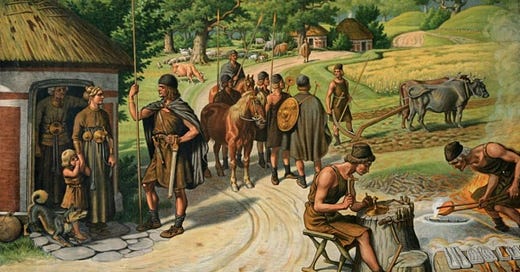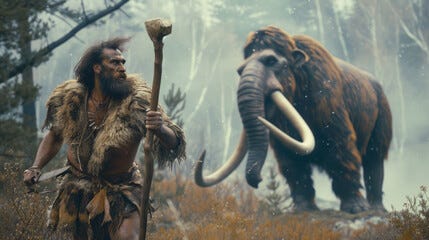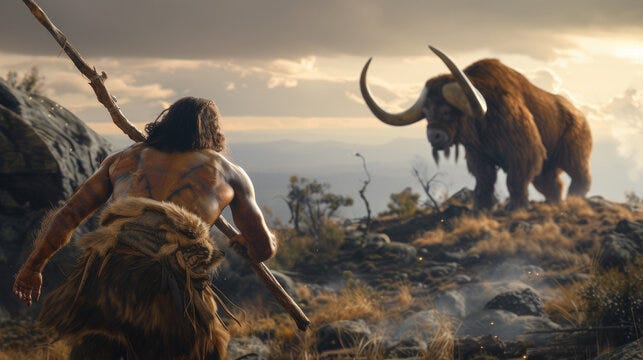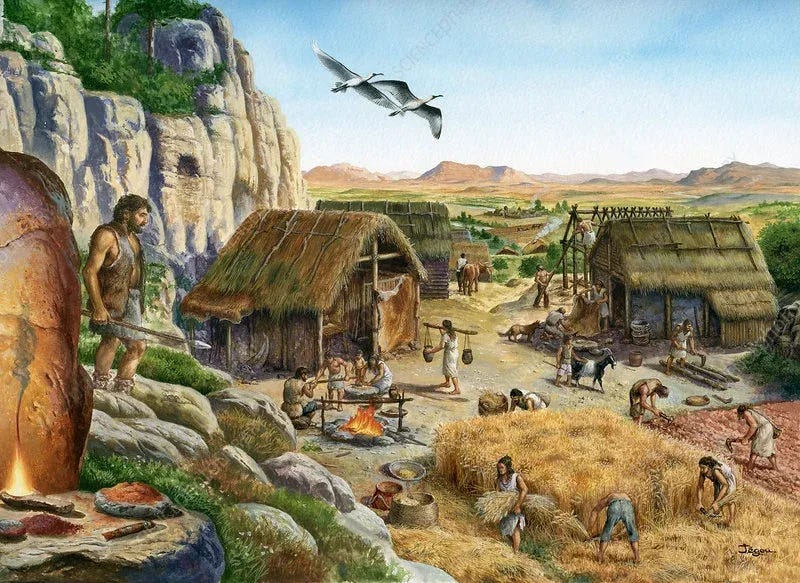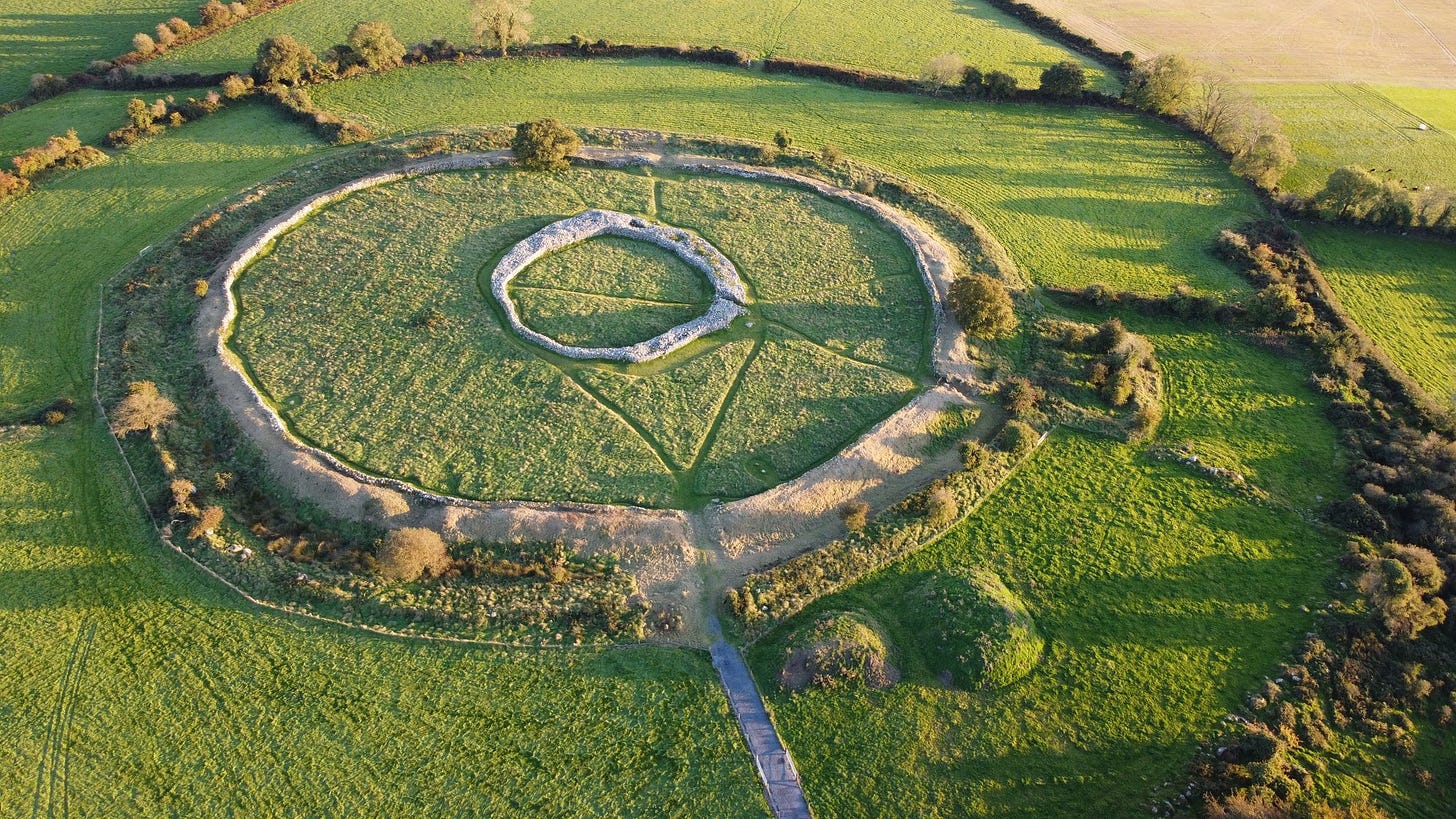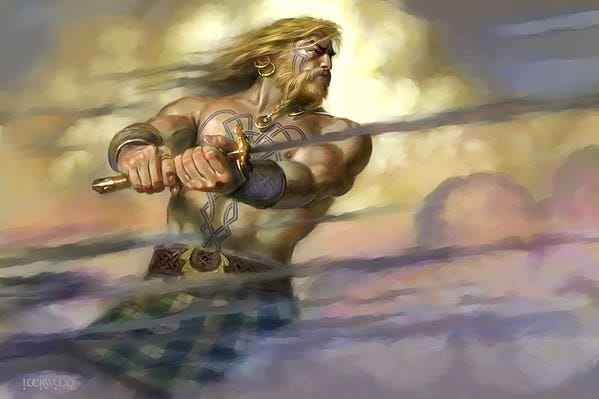Hello Dear Readers,
Today, we delve into one of the most interesting subjects in the history of human nature: food. Specifically, we will be delving into the diet of the European peoples and how they would change over time. So come, dear reader, take a seat around my fire and let’s begin. The sun rises and a new day’s labor on the ancient farm begins.
The Age of Advancements
In one point of view, the history of food is rather simple. Humans, as they evolved, lived, and existed in their various places of life, all ate what they could. All peoples on this planet first began as Hunter-Gatherers. This would mean that folks would go where the food was or settle where they could find food. This, however, would change as people would start to move around the Steppes and into Europe. More specifically, as the last Ice Age (which was 12,000 years ago) and their ice sheets retreated, people began to move North and West, from the Aegean Sea Area, into Italy, Spain, the Germanic States, Britain, Ireland and Scandinavia.
For the sake of simplicity and because I do not want to tell the entire story of human history, I am going to separate our times into periods that I like to call the Ages of Advancement or simply, the different ages in which people lived and their characteristics. Please note that there is some overlap between the ages:
Stone Age (3.3 million to 5,000 years ago):
Paleolithic
Also known as the Old Stone Age, this period began around 2.6 million years ago and ended with the last ice age around 9,000 B.C. It was characterized by hunting and gathering, and the use of primitive stone tools.
Mesolithic
The start and end of the Mesolithic period vary by region, but it was characterized by the development of agriculture and the rise of permanent settlements.
Neolithic
Also known as the New Stone Age, this period is considered to have occurred from around 10,200 B.C. to 4,500 B.C. It was characterized by the domestication of plants and animals, and the development of agriculture and permanent settlements. Neolithic people lived in farming villages and developed technologically sophisticated societies with temples, towers, kings, and priests.
Bronze Age (5,000 to 1,400 years ago): Characterized by the use of bronze for tools and weapons.
Iron Age (1,200 BC to 500 BC): Marked by the use of iron.
The Evolution of Diets Through the Ages
The diet of humans evolved significantly through these Ages of Advancement, reflecting the changes in technology, environment, and societal structure. As I have listed the different ages and their time frames above, I will list the different ages and their diets below.
The Stone Age Diet
The Paleolithic Diet
As mentioned, in this age, humans were predominantly hunter-gatherers, relying on the natural environment in which they existed for sustenance. Their diet consisted mainly of wild game such as deer, bison, and boar, which provided essential proteins and fats. Additionally, they hunted smaller animals and birds, and fished in rivers and coastal areas. Plant-based foods were also crucial, including wild fruits, nuts, seeds, roots, and leafy greens. The use of simple stone tools, which in itself is a significant technological advancement, allowed them to hunt and process these foods effectively.
The Mesolithic Diet
Here, there was a gradual shift in dietary practices as the climate warmed and forests expanded. This period saw an increase in the consumption of fish and shellfish, especially in coastal regions. People continued to gather wild plants and hunt animals, but there was a broader use of resources due to the development of new tools like microliths, which improved hunting and fishing efficiency.
The Neolithic Diet
The Neolithic diet marked a significant shift in dietary habits with the advent of agriculture. People began to settle in permanent villages and cultivate crops such as wheat, barley, peas, and lentils. The domestication of animals like cattle, sheep, goats, and pigs introduced a steady supply of meat, milk, and eggs into their diet. Dairy products, including milk, cheese, and yogurt, became dietary staples. The ability to store surplus food led to a more stable and reliable food supply. Another major diet shift was the introduction of sustained carbs such as ancient grains and legumes, which provided carbohydrates and plant proteins, along with continued consumption of wild and domesticated fruits and vegetables.
The Bronze Age Diet
The Bronze Age saw further advancements in agriculture and animal husbandry, leading to more diverse and sophisticated dietary practices. People continued to rely on crops like wheat, barley, and millet, but also cultivated new varieties of fruits and vegetables. The introduction of metal tools and plows improved farming efficiency, increasing crop yields. Dairy farming became more widespread, and products like butter and cheese were common. Meat consumption remained important, with livestock such as cattle, sheep, and pigs being primary sources. The Bronze Age diet also included bread, porridge, and beer made from fermented grains. The availability of surplus food also allowed for trade and the exchange of culinary practices between different regions.
The Iron Age Diet
In the Iron Age, dietary habits continued to evolve with technological advancements and increased social complexity. Iron tools and improved farming techniques further boosted agricultural productivity. People grew a variety of cereals, including wheat, barley, oats, and rye, and cultivated a wide range of vegetables and fruits. Legumes such as peas and beans were important protein sources, complementing meat and dairy products. The Iron Age diet also included processed foods like bread, cakes, and fermented beverages. Salt and other preservation methods allowed for the storage of meat and fish, ensuring a more consistent food supply throughout the year. Sounds familiar, doesn’t it?
The Farm
I would like to touch on the advent of farming as a separate topic as a whole because its effects it has had on the development of humanity as a whole has been nothing short of monumental.
I cannot understate how important farming would end up to be as it would lead to major cultural development. How you may ask? A good question, dear reader.
Take wheat for example. Once you plant wheat, it does not move, unlike a herd of reindeer. After it has been planted, one would need to cut it, separate it from the chaff, grind it into flour, etc. My point is that farming necessitated staying in or maintaining a claim to a specific area. This stability fostered the development of similar cultural practices among the people of the area, the evolution of a common language, and the maintenance of shared beliefs. It is also healthy for a people as a whole. A culture with greater food security and development also leads to higher birth rates. Higher birth rates mean a higher amount of warriors for your clan. More warriors means more resources and more security.
The Rathgall Hillfort of Ireland is a prime example of what an ancient farm would have looked like. The people and animals would enclose themselves in a circular hillfort which would be easily defensible and help protect themselves and their animals from any competing clans.
However, farming was inherently high-risk/high-reward due to the increased risk of war. The wealth generated from the domestication of plants and animals made stationary farming communities prime targets. Of course I am not talking of monetary wealth but a wealth of resources. These early farms attracted raids from other tribes, including those of hunter-gatherers who had not yet adopted agricultural practices.
Dairy
I also believe that in the scope of farming, we must also touch on the subject of dairy. In general, dairy also gives us some of the greatest insight into advancements in Northern European DNA and evolution. Nearly all babies around the world can digest milk but after they are weaned off of it, the body no longer has an active milk-digesting enzyme. However, this is different in Northern Europeans as they retain it. What is more interesting is that not every European people has the same level of tolerance to dairy but all peoples have some level of tolerance to it, which is fascinating.
An interesting note is it was the Celts in the British Isles that primarily focused on dairy. In fact, according to the British natural history museum, Celts adapted to drink milk nearly a millennium earlier than other Northern Europeans.
Starting 9,000 years ago, the body began to change as people started to drink milk into adulthood and adapt. However, it wasn't until about 5,000 years ago that a genetic mutation enabling continued production of lactase—the enzyme necessary for digesting milk—emerged in Europeans.
The development of the Northern European milk-digesting lactose enzyme was as a result of food scarcity. However, this certainly gave many Northern European cultures an advantage over others as food scarcity would have certainly existed in every culture in the ancient world at some point or another. When the Northern Europeans ran out of food, they could fall back on milk. When other cultures, ran out of food, they could not fall back on milk. They died. This helped lead to certain cultures being able to preserve themselves against nature and their enemies more effectively. This also meant that many cultures would be increasingly physically larger than others as the increased caloric intake and lack of food scarcity would help protect against a genetic decrease in size. This increase in size would also obviously help during times of war as the physical stature of a warrior could decide if you lived or died.
Well, dear reader, after such an engaging discussion, I find myself quite famished. Thank you for joining me on yet another adventure around the fire. I've had an excellent time, and I invite you to join me again. Next time, we'll journey to the Steppes to explore the ancient bond between people and their horses. Until then, take care and keep the flame of history burning.
-Flint

